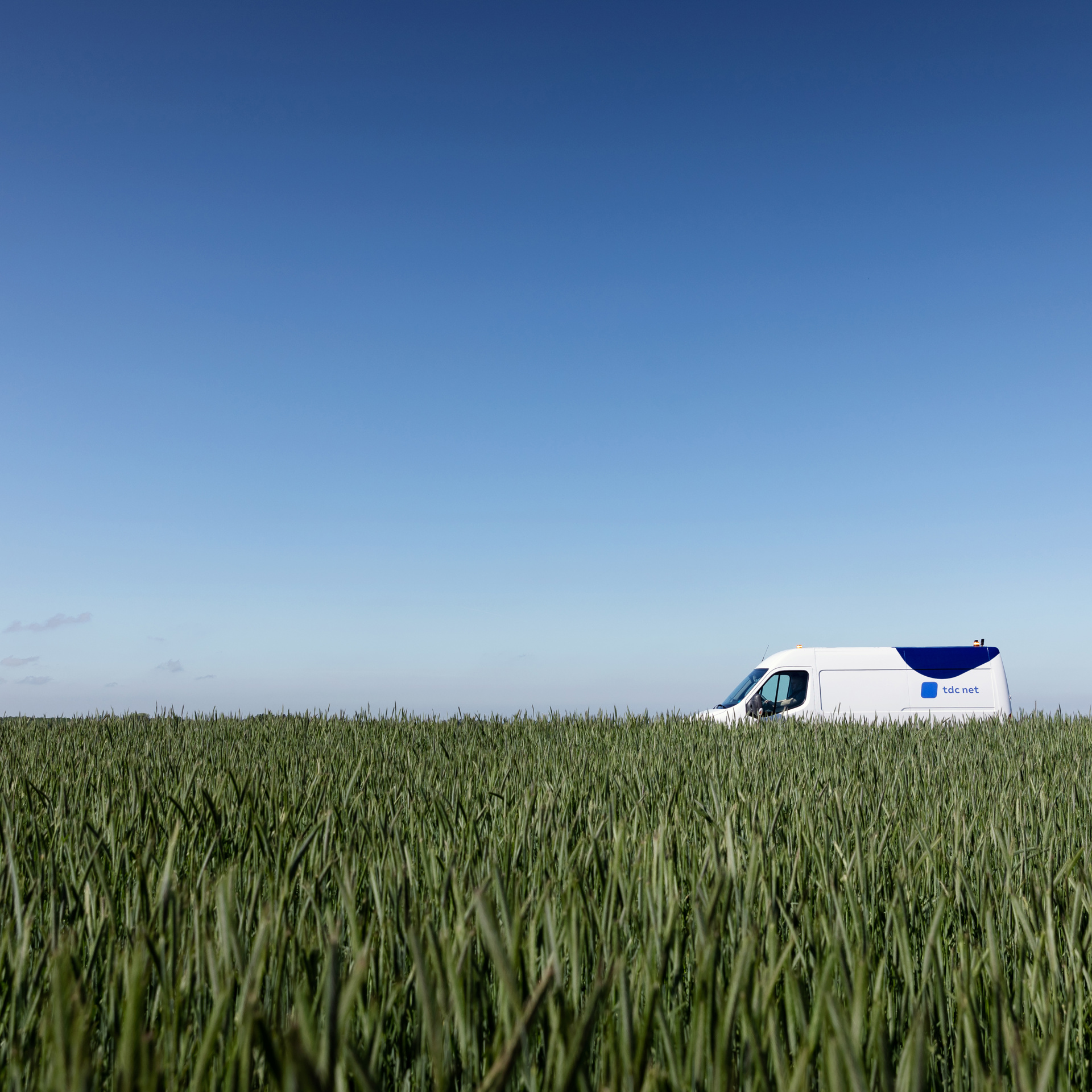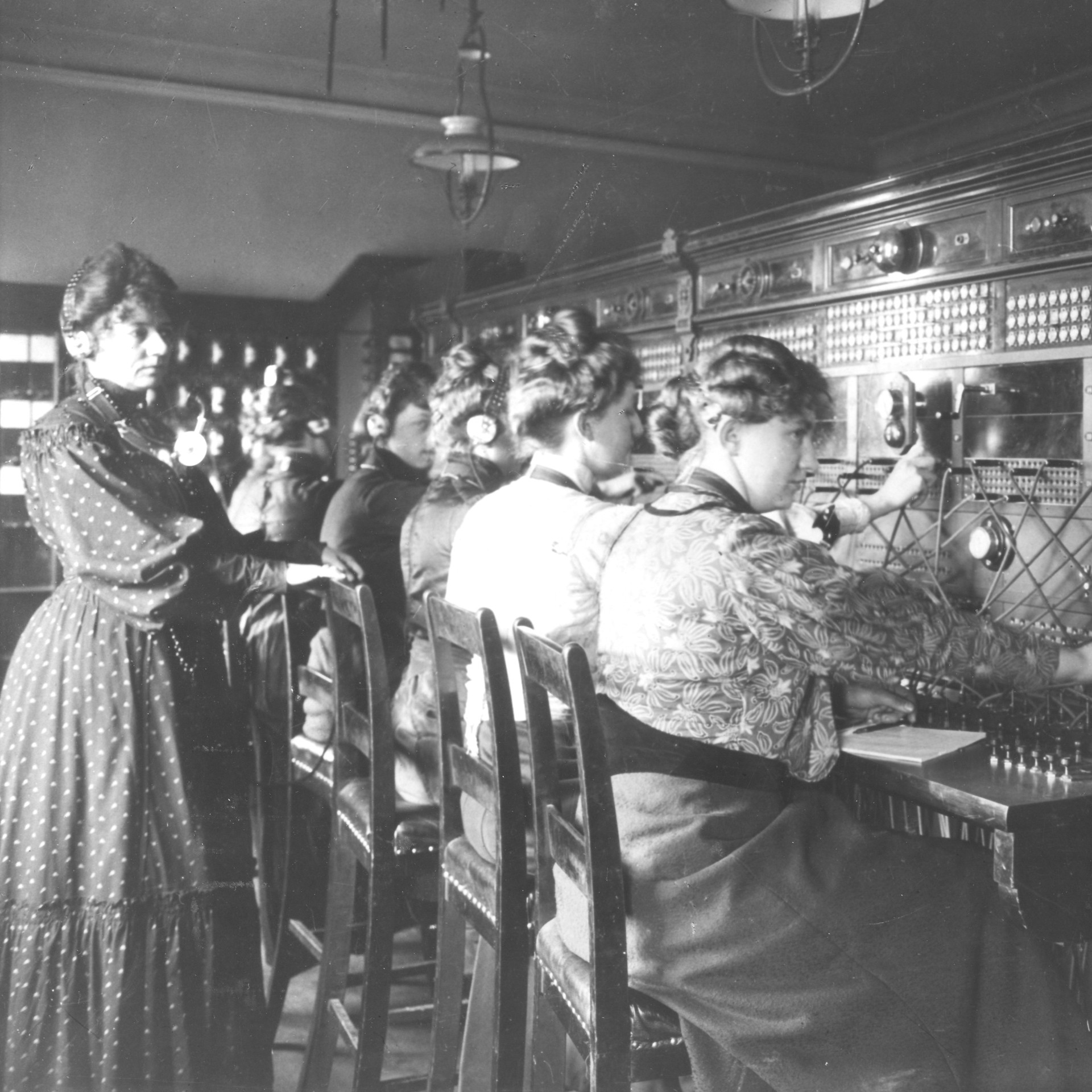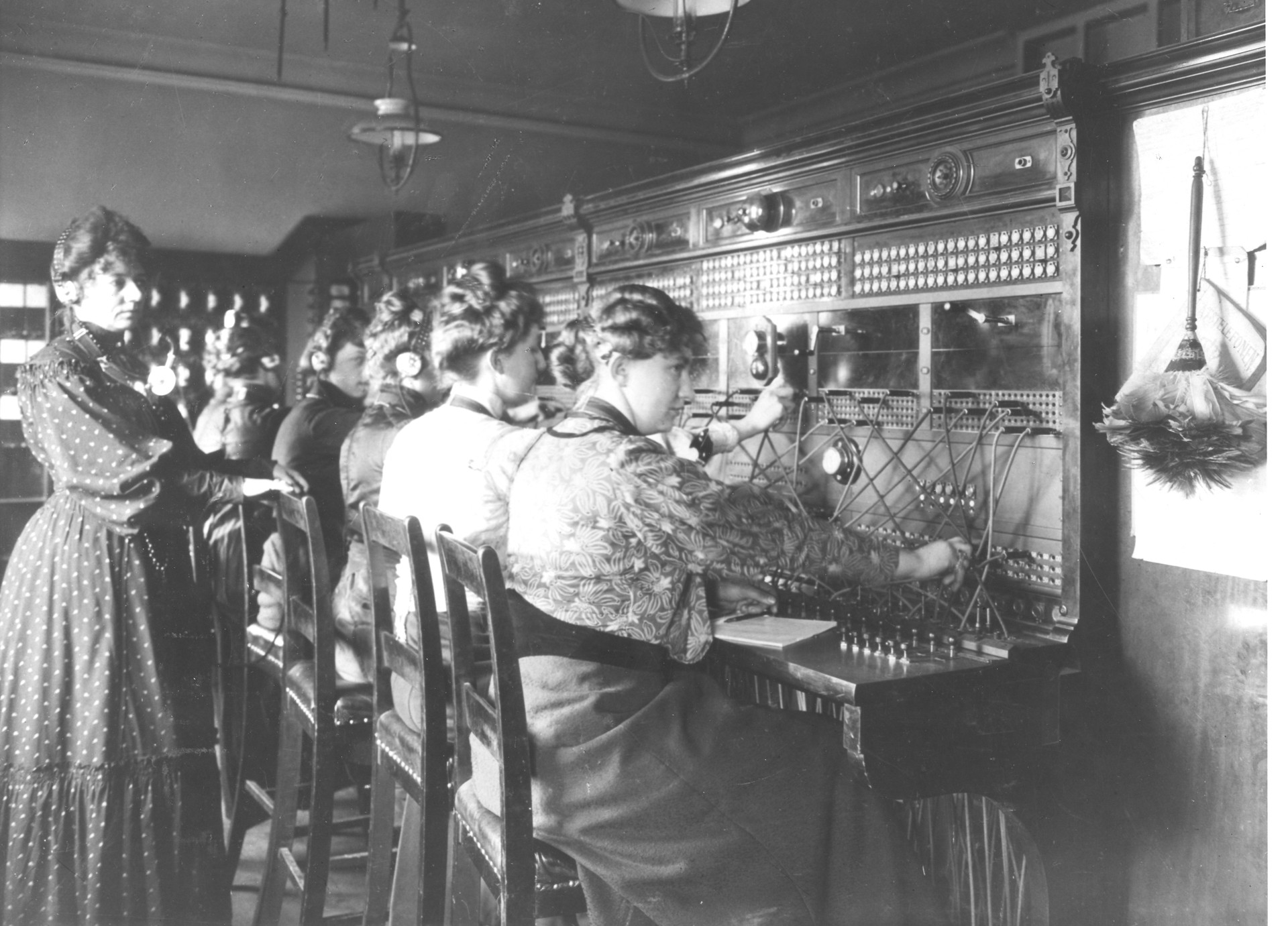TDC NET starts closing the copper network
The time has come to say goodbye to the copper network, and it will happen steadily up until 2029. The copper network is an old technology that has connected us for more than 140 years, first by telephony and later also by broadband. But gradually, more future-proof solutions have taken over, as they are more able to live up to the growing digital demands of the Danes.

The copper network is being closed in a few areas at a time
TDC NET has begun closing the copper network in the first 38 areas of the country with a total of 34.000 users. We are working together with providers of telephony and internet services in these areas, and we are doing our best to transfer customers to new internet solutions such as fiber or through the TV socket. Every affected customer will be notified when the copper network is closed. If you are one of the affected customers, you will be notified by your service provider beforehand so that you can be transferred to a new solution on landline, internet and TV.

Check your address to see if you can get lightning fast internet

The work continues until 2029
The plan is to have closed the last copper connections by 2029. It has not yet been decided when the given areas will be closed. Among other factors, it depends on the experiences that we acquire in the time to come. We will continuously inform providers of telephony and internet services of the upcoming copper closings. In that way, service providers are able to ensure that customers in households and businesses experience the best possible transition to other internet technologies.

An era is ending
It is a great era that is slowly coming to an end. When the businessman C. F. Tietgen started connecting Denmark through the copper network in 1882, he could hardly have imagined the revolution it would be to Danes. The copper adventure started when the very first telephone line was installed in the old stock exchange building in Copenhagen. 2001 became a high point for the copper network in Denmark. With approximately 230,000 kilometers of underground copper cables, the copper network was the main communication channel which made it possible for almost 3.8 million Danes to pick up the phone and call each other. Now, evolution has moved towards new technologies, and today, only 150,000 Danes own a landline telephone through the copper network, and approximately 300,000 Danes have internet via copper.
The Danes are under digital expansion
It is an entirely natural evolution when new and improved technologies gradually take over. Faster and more stable broadband connections are spreading and have outpaced the copper network which no longer lives up to our new demands.
Every year, nearly 100,000 Danes replace their old copper connection with new, more stable and secure highspeed internet such as fiber and internet through the TV socket (coax). Over just a few years, our digital habits have changed:
- In many homes, the internet is constantly in use. TV, thermostats, alarm devices, computers, tablets – even refrigerators use internet today. It requires a future-proof connection.
- We are streaming, gaming, surfing, working from home – or doing it all at once – and the copper network struggles to keep up.
- With fiber and internet through the TV socket, we are able to have a secure and stable highspeed internet which is ready for our digital demands both now and in the future.

”The copper network has served us all well during an important time for Denmark, and we have reason to take our hat off for a technology that has been operational for such a long time. The past years, Danes have, however, chosen new and stronger technologies – particularly fiber and coax – and deselected the copper network. For that reason, it no longer makes sense to maintain the copper network in Denmark.”
Robert Dogonowski, Chief Commercial Officer at TDC NET
Questions and answers
- Why are you closing the copper network?
Because it is more than 140 years old; it is outdated and unable to live up to our growing digital demands for broadband solutions. Fortunately, today, most people are able to choose better and more future-proof technologies such as fiber and internet through the TV socket (coax).
- When will the entire copper network be closed?
Our plan is to close the last copper connections in 2029. We are not planning on closing the entire copper network overnight. It is a large task which must be managed in a controlled pace. That is why we are phasing out the copper network steadily, from area to area.
- How will I be notified if my copper access is to be closed?
If your address is situated in one of the 38 areas that will be closed to begin with, your provider of telephony and internet services has already been notified by us and will contact you directly. The majority of the areas are situated in North Zealand but the areas also cover the metropolitan area, Roskilde and Odense. Contact your provider of telephony and internet services if you want to know whether your connection falls under one of the 38 areas which will be closed this time round.
TDC NET’s plan is to have closed the copper network in all areas before the end of 2029. It is yet to be decided which main facilities or areas will be closed next.
If you already wish to know more about your options now, you may reach out to your provider of telephony and internet services. You can also check whether you can have lightening-fast internet through one af TDC NET’s networks by looking up your address at tdcnet.dk and read more about your options.
- I can’t wait. Can I replace my network from copper already now?
If you wish to replace your copper connection now and want to hear more about your options, you may contact your internet provider. You can also check whether you can have lightening-fast internet through one of TDC NET’s networks by looking up your address at tdcnet.dk and read more about your options.
We are continuously rolling out fiber in new areas for households and businesses, and your address might be next.
- How do I know if my telephone or internet connection is through copper?
When your internet is through the copper network, the connection runs through your telephone cable. That is why the copper connection is also called broadband through the telephone socket - or DSL. If you are uncertain of which connection you have, you may ask your internet provider.
If you have internet through the copper network, a specific speed or stability in your connection can’t be guaranteed. Even though the copper network has been maintained throughout the years, the distance from your home to the nearest connection point might cause delays and lower speed in your internet connection.
- Am I at risk that my internet or my landline telephone suddenly stops working?
No. The copper network will be phased out steadily so you don’t have to worry about whether your internet connection or telephone suddenly stops working. TDC NET won’t turn off your copper connection overnight. We have given all providers of telephony and internet services 13 months’ notice of which areas will close down first time round. If you have telephony or internet through the copper network and live in one of those areas, your provider of telephony and internet services will contact you about your future options, so you won’t suddenly be missing your internet connection or landline telephone.
- Can I keep my landline telephone?
Good solutions already exist for landline telephony through fiber, through the TV socket or other technologies. If you want to hear more about your options, you may reach out to your service provider.
The copper network: an important connection in the history of Denmark
1882
The first copper wire is switched on
Denmark had its first telephone line in 1892. The businessman C. F. Tietgen had the installation made through copper wire in the old stock exchange building in the heart of Copenhagen. Even with his acute business talent and interest for new technologies, he most certainly couldn’t have imagined which revolution it would be for Danes. Or that the copper network would still be in use more than 140 years later.
2001
The copper network peaks
The culmination of the copper network evolution happens in 2001. With approximately 230,000 kilometers of underground copper cables, the copper network were the most important communication channel in Denmark and made it possible for almost 3.8 million Danes to pick up the phone and call each other.

2020s
The phase-out is prepared
The past years, in co-operation with providers of telephony and internet services, TDC NET has been preparing thoroughly and acquiring important experiences with closing of the copper network. We’ve become wiser about how to transfer customers to new technologies in a sensible and secure manner.
In 2022, we carried out a pilot project on Askø where we closed the copper network in a minor area. The pilot project provided us with valuable insights which, along with the last preparation work, have geared us up for beginning the phase-out of the copper network.

1880s and 90s
The state gets a monopoly hold over telephony
At the end of the century, several local telephone companies were established around the largest cities in the country, and at the turn of the century, a total of 57 telephone companies existed in Denmark. The telephone had become an important form of communication, and in 1897, the state had a monopoly hold over constructing and managing telephony.

2010s
The popularity plunges
I takt med udbredelsen af nye og forbedrede teknologier dropper flere og flere danskere kobberteknologien til fordel for hurtige og stabile internetforbindelser eksempelvis via fiber eller gennem tv-stikket.
I dag er det kun cirka 150.000, der har fastnettelefon, mens cirka 300.000 bruger kobbernettet som internetforbindelse. Alene i 2023 skiftede 100.000 kunder deres bredbånd og 45.000 deres fastnettelefoni til en nyere teknologi. Myndighedernes seneste analyser viser, at allerede i 2025 vil 98-99 % af danskerne vil have adgang til lynhurtigt internet (1 gigabyte downloadhastighed), primært på fiber.
2024
Closing of the copper network begins
TDC NET takes the first important step and begins closing the copper network in 38 areas with approximately 34.000 customers. It is primarly areas in North Zealand and also the metropolitan area, Roskilde and Odense.
The co-operation with providers of telephony and internet services continues, so that we are continuously able to become wiser and together solve the challenges that might occur.
2029
The last copper connection will be turned off
The plan is to have closed all areas with copper network and thereby turn off the last connections on the copper network during 2029.
When the entire copper network has been closed, we expect that the 300,000 current customers on the copper network will have been transferred to a more stable, secure and fast broadband connection. A connection that is far more able to cover the growing digital demands in households both now and in the future.
1882
The first copper wire is switched on
Denmark had its first telephone line in 1892. The businessman C. F. Tietgen had the installation made through copper wire in the old stock exchange building in the heart of Copenhagen. Even with his acute business talent and interest for new technologies, he most certainly couldn’t have imagined which revolution it would be for Danes. Or that the copper network would still be in use more than 140 years later.
1880s and 90s
The state gets a monopoly hold over telephony
At the end of the century, several local telephone companies were established around the largest cities in the country, and at the turn of the century, a total of 57 telephone companies existed in Denmark. The telephone had become an important form of communication, and in 1897, the state had a monopoly hold over constructing and managing telephony.

2001
The copper network peaks
The culmination of the copper network evolution happens in 2001. With approximately 230,000 kilometers of underground copper cables, the copper network were the most important communication channel in Denmark and made it possible for almost 3.8 million Danes to pick up the phone and call each other.

2010s
The popularity plunges
I takt med udbredelsen af nye og forbedrede teknologier dropper flere og flere danskere kobberteknologien til fordel for hurtige og stabile internetforbindelser eksempelvis via fiber eller gennem tv-stikket.
I dag er det kun cirka 150.000, der har fastnettelefon, mens cirka 300.000 bruger kobbernettet som internetforbindelse. Alene i 2023 skiftede 100.000 kunder deres bredbånd og 45.000 deres fastnettelefoni til en nyere teknologi. Myndighedernes seneste analyser viser, at allerede i 2025 vil 98-99 % af danskerne vil have adgang til lynhurtigt internet (1 gigabyte downloadhastighed), primært på fiber.
2020s
The phase-out is prepared
The past years, in co-operation with providers of telephony and internet services, TDC NET has been preparing thoroughly and acquiring important experiences with closing of the copper network. We’ve become wiser about how to transfer customers to new technologies in a sensible and secure manner.
In 2022, we carried out a pilot project on Askø where we closed the copper network in a minor area. The pilot project provided us with valuable insights which, along with the last preparation work, have geared us up for beginning the phase-out of the copper network.

2024
Closing of the copper network begins
TDC NET takes the first important step and begins closing the copper network in 38 areas with approximately 34.000 customers. It is primarly areas in North Zealand and also the metropolitan area, Roskilde and Odense.
The co-operation with providers of telephony and internet services continues, so that we are continuously able to become wiser and together solve the challenges that might occur.
2029
The last copper connection will be turned off
The plan is to have closed all areas with copper network and thereby turn off the last connections on the copper network during 2029.
When the entire copper network has been closed, we expect that the 300,000 current customers on the copper network will have been transferred to a more stable, secure and fast broadband connection. A connection that is far more able to cover the growing digital demands in households both now and in the future.